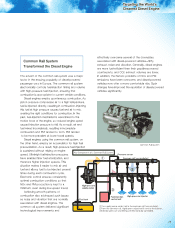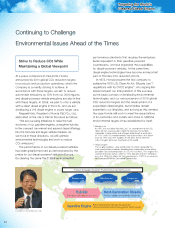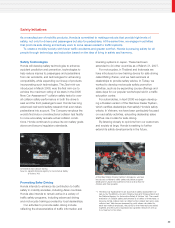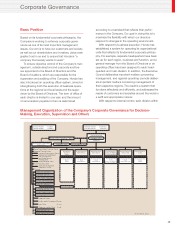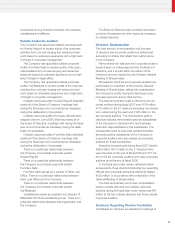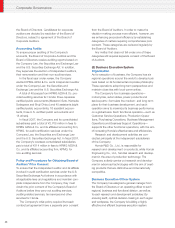Honda 2007 Annual Report Download - page 39
Download and view the complete annual report
Please find page 39 of the 2007 Honda annual report below. You can navigate through the pages in the report by either clicking on the pages listed below, or by using the keyword search tool below to find specific information within the annual report.
37
Honda’s Advanced Environmental Initiatives
Honda’s mission is to operate manufacturing facilities
throughout the world that place as little burden on
the environment as possible as they manufacture
products with superior environmental performance.
Following is a look at the environmental performance
of automobiles in our major regions. Through our
unique technologies, Honda introduces products
that demonstrate environmental performance that
exceeds the regulations established in each region
for the reduction of emissions and improvement of
fuel efficiency. It is our responsibility to contribute to
the achievement of a sustainable mobility society by
meeting people’s mobility needs while minimizing the
environmental impacts caused by our products. In
the product domain, we are implementing measures
based on the following three approaches.
1. Further improvements in the reduction of emis-
sions from internal combustion engines and
improvement of fuel efficiency
2. Evolution of hybrid vehicles
3. Promotion of alternative fuel-powered vehicles
1. Further Improvements in the Reduction of
Emissions from Internal Combustion Engines
and Improvement of Fuel Efficiency
• North America (the United States)
In the United States, Honda continues to lead the
automotive industry in corporate average fuel
economy for cars and trucks combined. Moreover,
in terms of cleaner emissions all Honda and Acura
brand vehicles meet or exceed the U.S. EPA*1’s strin-
gent TierII Bin5*2 exhaust gas standard for clean
emissions.
• Europe
In Europe, since the introduction of the 2001 Civic
(with some local variations) Honda has promoted
reductions in exhaust emissions by ensuring that all
models meet the Euro4 emissions standard when
they undergo full model changes. By increasing the
fuel economy of existing models and introducing
hybrid and diesel vehicles, we are steadily reducing
vehicle CO2 emissions, particularly for diesel vehicles.
Since the Accord equipped with a Honda-developed
2.2-liter engine went on sale in December 2003, we
have equipped the FR-V (called Edix in Japan) with
this engine. In January 2006, we also began offering
the new Civic with this engine. In January 2007, we
released a new CR-V equipped with a diesel particu-
late filter (DPF)*3 to achieve higher fuel efficiency and
cleaner exhaust.
• Asia
In Thailand, Honda’s locally produced Jazz (called Fit
in Japan) has already achieved the Euro4 emissions
standard, which is to be required in the future. Since
the introduction of the Jazz, all models introduced in
Thailand have achieved the Euro4 emissions stan-
dard. The new Civic, introduced in 2005, and the new
CR-V, introduced in 2006, are also made in Thailand
and are compliant with the Euro4*4 emissions
standard.
• China
Honda has attained Europe’s Euro4*4 emissions stan-
dards ahead of Chinese regulations for all models
introduced in the country. In July 2007, the Company
plans to release the Civic Hybrid, a vehicle with even
higher fuel efficiency than the City (called Fit ARIA in
Japan) and the Civic, which are already at the top of
their class in this area.
2. Evolution of Hybrid Vehicles
In November 1999, Honda introduced the Insight,
the first hybrid vehicle equipped with the Honda inte-
grated motor assist (IMA*5) system, achieving the
world’s highest fuel economy among mass-produced
gasoline-powered vehicles. In December 2001, we
introduced the Civic Hybrid, and in December 2004,
we began sales in North America of the Accord
Hybrid, adopting Honda’s Variable Cylinder Manage-
ment system for its V6 engine. Further, in November
2005 we began sales of an all-new Civic Hybrid,
equipped with the new 3-Stage i-VTEC + IMA Honda
Hybrid System. In the future, Honda is developing a
new dedicated hybrid vehicle suitable for family use in
major automobile markets in the world. With this new
dedicated hybrid vehicle, Honda will achieve further
advancement of fuel efficient technologies and a
reduction in cost. We plan to contribute to the reduc-
tion of CO2 emissions by delivering hybrid vehicles
that are priced affordably enough to be practical for
more customers throughout the world.




